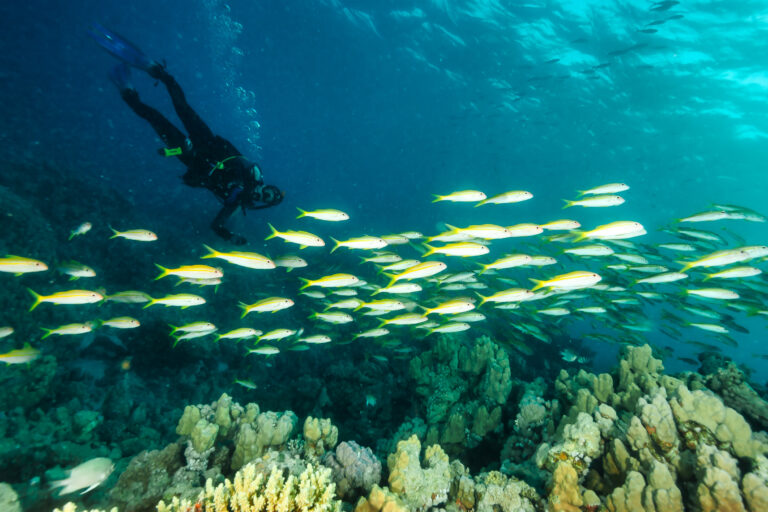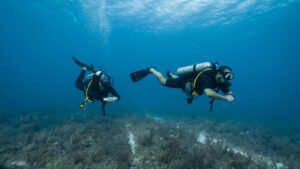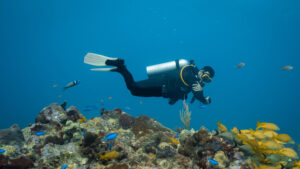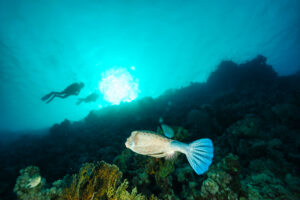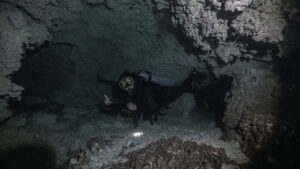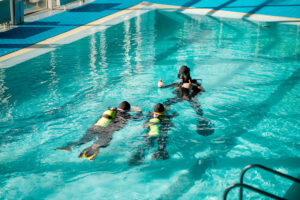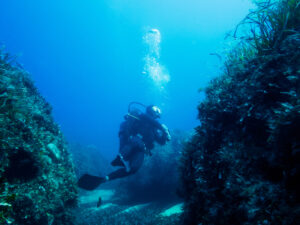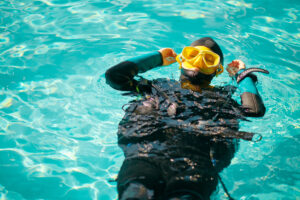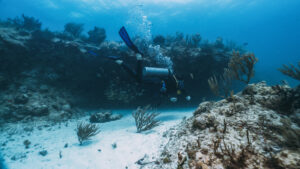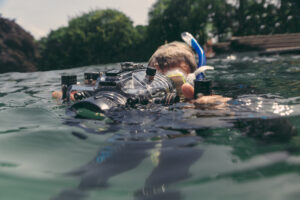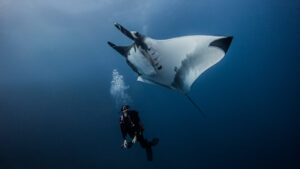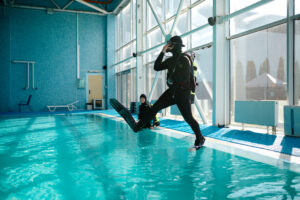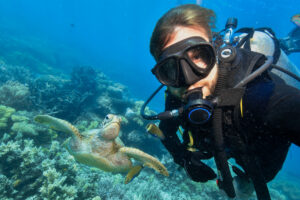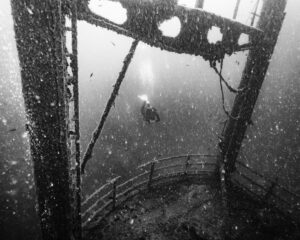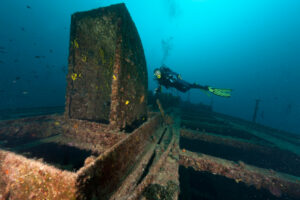What is a Pony Bottle?
A pony bottle, in the context of scuba diving, refers to a small, independent scuba cylinder that acts as an emergency air supply. Divers often rely on pony bottles as a crucial backup system in case their primary air source fails. This additional cylinder provides a diver with an extra layer of safety, ensuring they have enough breathable gas to reach the surface or their dive buddy in the event of an emergency. The name “pony bottle” aptly describes its role as a smaller companion to the main tank, much like a pony is to a horse. Understanding the function and proper use of a pony bottle is essential for any diver who values safety and preparedness underwater.
Definition and Description
A pony bottle is a compact, secondary scuba tank designed to provide a diver with an independent source of air. Typically ranging in size from 0.85 liters (3 cubic feet) to 6 liters (40 cubic feet), pony bottles are significantly smaller than the primary scuba cylinder, which usually holds about 11 liters (80 cubic feet). These bottles are made from durable materials like aluminum or steel, designed to withstand the harsh conditions of underwater environments.
The primary purpose of a pony bottle is to serve as an emergency backup air supply. In contrast to larger twin-tank setups, a pony bottle offers a simpler and more lightweight solution for redundant air. The smaller size and capacity of a pony bottle mean it is less cumbersome, making it an attractive option for divers who prefer a streamlined gear setup. Despite their smaller capacity, pony bottles can provide enough air to make a safe ascent from typical recreational diving depths.
Comparatively, the pony bottle differs from the main tank not just in size but in its integration into the diver’s gear. While the main tank is used throughout the dive, the pony bottle remains unused unless an emergency arises. The distinction is crucial: the pony bottle is not intended to extend the dive time but to provide a margin of safety in unforeseen circumstances. This differentiation underscores the importance of understanding and correctly setting up this vital piece of equipment.
Historical Development
The concept of the pony bottle has its roots in the early days of scuba diving when divers began to recognize the need for redundant air supplies. Originally, divers relied on twin-tank systems or buddy breathing techniques to manage emergencies. However, these methods had limitations and potential risks, leading to the development of more reliable and independent backup systems.
In the 1960s and 1970s, as scuba diving grew in popularity, technological advancements allowed for the production of smaller, more efficient scuba cylinders. These innovations made it feasible to carry an additional, smaller tank without significantly increasing the diver’s burden. Early pony bottles were often homemade solutions, crafted by divers who modified existing equipment to suit their needs.
By the 1980s, the commercial availability of pony bottles began to rise, driven by the increasing demand for safer diving practices. Manufacturers started producing standardized pony bottles, complete with dedicated mounting systems and compatible regulators. This period marked a significant shift in diving safety culture, emphasizing the importance of personal responsibility and self-rescue capabilities.
The evolution of materials and design continued into the 21st century, with modern pony bottles featuring lightweight aluminum or composite construction, ergonomic designs, and advanced regulator systems. These improvements have made pony bottles more accessible and practical for recreational and technical divers alike, solidifying their place as a critical safety device in the scuba diving community.
Uses and Applications
The primary function of a pony bottle is to act as an emergency air supply, providing divers with a reliable backup in case of primary air source failure. This redundancy is especially crucial in environments where a direct ascent to the surface is not possible or advisable, such as deep dives, wreck penetrations, and cave diving. In these scenarios, the pony bottle ensures that a diver has enough breathable gas to navigate out of the hazardous area and ascend safely.
In deep diving situations, the pony bottle can be a lifesaver. Divers operating at significant depths are at greater risk of encountering issues like regulator failure, gas supply problems, or entanglement. A pony bottle, with its independent air supply, allows divers to manage these emergencies without relying on their buddy’s air supply, which may also be limited. The presence of a pony bottle provides an additional layer of security, reducing the likelihood of a critical situation turning fatal.
Cave and wreck divers also benefit significantly from carrying pony bottles. These environments are inherently more dangerous due to limited visibility, confined spaces, and potential entanglements. In such conditions, the ability to switch to an independent air source can make the difference between a manageable emergency and a dire situation. The pony bottle’s compact size allows it to be carried without impeding the diver’s ability to navigate through tight passages.
The advantages of a pony bottle extend beyond technical diving. Recreational divers can also benefit from carrying a pony bottle, particularly when diving in remote locations or when diving solo. In these cases, the pony bottle acts as a safety net, ensuring that divers have a reliable air supply even if their main tank or regulator fails. The peace of mind provided by a pony bottle encourages more responsible and relaxed diving practices, ultimately enhancing the overall safety and enjoyment of the dive.
Setup and Integration
Proper setup and integration of a pony bottle into the diving gear are essential for its effective use. The first step is selecting the appropriate size of the pony bottle based on the type of diving and the diver’s air consumption rate. Common sizes include 1.5 liters (13 cubic feet), 3 liters (30 cubic feet), and 6 liters (40 cubic feet). The chosen size should provide enough air for the diver to make a safe ascent, taking into account potential delays and decompression stops.
Mounting options for the pony bottle vary, with the most common methods being side mount, sling, or attachment to the main tank. Side mounting involves securing the pony bottle along the diver’s side, making it easily accessible while maintaining a streamlined profile. Sling mounting, often used by technical divers, allows the pony bottle to be carried in front of the diver, clipped to the harness D-rings. This method provides quick access and easy detachment in emergencies.
Attaching the pony bottle to the main tank is another popular method, especially among recreational divers. This setup involves securing the pony bottle to the main cylinder using clamps or straps. The advantage of this configuration is that it keeps the pony bottle in a fixed position, reducing drag and minimizing entanglement risks. However, it may be less accessible than side or sling mounting, requiring careful consideration of the regulator and hose routing.
Choosing the right regulator and connections for the pony bottle is crucial. Divers typically use a dedicated regulator for the pony bottle, ensuring it is always ready for use. This regulator should be easily distinguishable from the primary regulator to prevent confusion during an emergency. Some divers opt for a compact regulator with a short hose, while others prefer a full-sized regulator with a standard-length hose, depending on personal preference and the chosen mounting method.
Safety Protocols and Training
The effective use of a pony bottle requires proper training and adherence to safety protocols. Divers must be familiar with the operation and deployment of the pony bottle, including switching regulators and managing buoyancy while using the backup air supply. Training programs offered by diving organizations often include specific modules on redundant air systems, ensuring that divers are well-prepared to handle emergencies.
One essential aspect of pony bottle training is practicing the transition from the primary air source to the pony bottle. This exercise should be performed regularly, both in controlled environments like swimming pools and in open water conditions. Familiarity with the process ensures that divers can make the switch quickly and confidently in real-life scenarios, reducing panic and maintaining composure.
Certification courses for technical diving often emphasize the use of redundant air supplies, including pony bottles. These courses cover advanced diving techniques, emergency procedures, and equipment configurations, providing divers with the knowledge and skills needed to safely use pony bottles. Even recreational divers can benefit from taking specialty courses focused on self-rescue and redundant air systems, enhancing their overall safety and preparedness.
Maintaining the pony bottle and its associated equipment is another critical component of safety. Regular inspections and maintenance routines should be established to ensure the bottle and regulator are in good working condition. This includes checking for leaks, inspecting O-rings, and ensuring that the regulator is functioning correctly. A well-maintained pony bottle is a reliable piece of equipment that can be depended upon in emergencies.
Controversies and Limitations
Despite the clear benefits, the use of pony bottles in scuba diving is not without controversy. Some divers and experts debate the necessity of pony bottles for recreational divers, arguing that proper planning and adherence to safety protocols should eliminate the need for redundant air supplies. They contend that carrying additional equipment can increase complexity and potential entanglement risks, outweighing the benefits for recreational dives.
Critics also point to the limitations of pony bottles in terms of air capacity and depth. A typical pony bottle may not provide sufficient air for prolonged emergencies, especially at deeper depths where air consumption is higher. In such cases, other redundant air systems, like twin-tank configurations or sidemount setups, may offer more substantial benefits. Divers must carefully assess their needs and the conditions of their dives to determine the most appropriate backup system.
Potential risks associated with pony bottles include improper setup, inadequate training, and reliance on the backup system. Divers who are not thoroughly trained in using a pony bottle may experience difficulties in deploying it during an emergency, leading to confusion and increased risk. Additionally, over-reliance on the pony bottle as a safety net may result in complacency and poor planning, increasing the likelihood of encountering emergencies in the first place.
Common mistakes made by divers using pony bottles include failing to perform regular maintenance, incorrect mounting, and not practicing emergency procedures. Ensuring that the pony bottle is correctly integrated into the diving gear and that the diver is proficient in its use is essential for mitigating these risks. Educating divers on the proper use and limitations of pony bottles can help address some of the controversies and enhance overall diving safety.
Key Takeaways
The pony bottle serves as a critical safety device in scuba diving, providing an independent backup air supply in emergencies. Its role in enhancing diver safety is especially significant in deep, cave, and wreck diving scenarios where direct ascents are not always possible. Proper setup, training, and maintenance are crucial for the effective use of a pony bottle, and understanding its limitations helps divers make informed decisions about their gear. While the necessity of pony bottles for recreational diving may be debated, their value in promoting responsible and safe diving practices is undeniable.

